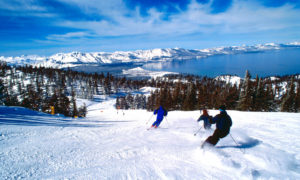Although the current storm is not good news for Lake Tahoe ski resorts, a more favorable forecast could result in as much as 14 inches of snow early next week in the mountains.
According to Snow Forecaster Bryan Allegretto, before the storm moves out of the Lake Tahoe region Wednesday morning it could result in 3-14 inches at Lake Tahoe ski resorts. That would be the first significant snow accumulation since November.

Light rain showers are taking place Friday (Jan. 5) in the Tahoe region. The rain is predominant except at 8,500-foot elevation, where snow levels start to accumulate. The mountain top is no place to hang out, thanks to severe winds registered at 50-60 mph.
Another wave of rain is likely for Saturday and once again will not result in no snow at lower levels. According to Allegretto, the snow levels should be at 7,000 feet and above.
By Saturday afternoon there could be 1-2 inches of snow at 7,000 feet and possibly 3-10 inches at 8,000 and above. Winds will again be gusting in the 50-60 mph range on the mountain tops.
Sunday appears to be the most pleasant day for skiers and snowboarders. The weather should be partly sunny with temperatures in the 40s.
Another wet storm arrives Monday and continues into Tuesday. Snow levels will start at approximately 9,000 feet on Monday and drop to perhaps 8,000 that evening. However, by Tuesday morning the snow may dip to lake level where 2-4 inches could accumulate.
SNOW SURVEY: On Jan. 3 the California Department of Water Resources recorded an average depth of 1.3 inches of snow in the field adjacent to the entrance of Sierra-at-Tahoe ski resort.
This amount equates to a water content of 0.4 inches. This is 3 percent of the long-term average for this location at this time of year.
Throughout California, the snowpack is very low. Statewide, the snowpack water equivalency is 2.6 inches, or 24 percent of the Jan. 3 average.
However, it’s still early. “There is still a lot of winter left,” Frank Gehrke, who annually conducts the survey near Echo Summit. “January, February and into March are frequently productive.”
Gehrke noted that last January was better in comparison. The first quarter of 2017 produced the abundance of snow. And many times that is the case.
California traditionally receives about half of its annual precipitation during December, January and February.